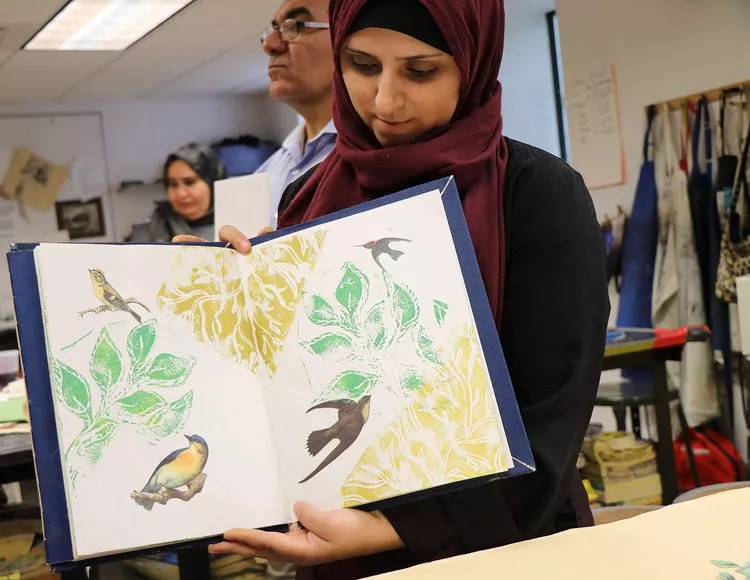In this unprecedented era of mass migration, the U.N. counts 25.4 million international refugees, fleeing death, conscription, and brutalization. If they find asylum in a country like the U.S., few long-term transition resources await them. Out of the whirlwind, resettled people often find themselves marooned in a strange and unfamiliar land.
To explore the current migration moment, Swarthmore College Libraries and the Lang Center for Civic & Social Responsibility will unveil a multi-venue book arts show that begins March 29 at McCabe Library. It represents the culmination of a wide-ranging program: Friends, Peace, and Sanctuary (FPS), which features the creative voices of resettled Syrians and Iraqis now living in Philadelphia.
Activating archival materials to connect to contemporary experiences, sharing displacement narratives that reflect multiple cultures, and offering interventions to support refugee resettlement, all of the art embraces the form and history of the book as a physical object.
FPS is the brainchild of College Librarian Peggy Ann Seiden, who developed the idea after an encounter with an archival holding on a Jewish family that fled the Nazis.
“I started thinking about evidence we have about earlier refugee movements,” she says, “and how that could be brought into conversation with what’s going on currently.”
...
After the project launched in 2016, it expanded to include an engaged-scholarship course; a collaborative series of undergrad programs, Searching for Sanctuary; and additional workshops for faculty, staff, students, and collaborators through a President’s Office Mellon grant.
“This project builds upon Swarthmore’s history as a Quaker institution founded on a commitment to social justice,” says Katie Price, assistant director for co-curricular programming and outreach at the Lang Center for Civic & Social Responsibility. “It extends our resources to meet local community needs, and enriches the student experience by providing an opportunity to learn from these communities.”
Islam Aly, an Egypt-born artist and professor at the University of Northern Iowa, is one of the five FPS-commissioned teaching artists. Like the others—Erik Ruin, Maureen Cummins, Mark Strandquist, and Courtney Bowles—Aly ran a series of multigenerational workshops. Attended by about 20 Syrians and Iraqis, Aly’s North Philadelphia workshop involved lectures on the history of books and hands-on opportunities for participants to create their own work in the “dos-à-dos” binding style.

Asmaa Diab showing her art in Islam Aly’s workshop. Hussam Al-Obaidi
“A lot of our participants are experiencing two different cultures or languages,” Aly says, “so the book itself makes it possible to have text on one side and images on the other, or English and Arabic, or a story told by two different people.”
One book created by a cook named Ossama, who affixed spices to his pages in plastic bags, tells the story and sensory details of his favorite recipes. Another book, created by married couple Asmaa and Hassan, uses an avian-decorated paper sample to tell a story about the birds that surrounded their home before it was bombed. (These works and others like them will be included in this spring’s exhibition.)
“More and more people have heard about the project and wanted to get involved,” Price says. “That’s our biggest testament to success: These families are not only sticking with it, but recruiting others.”
Another participant, Mohammed, was a bookseller on the famous Mutanabbi Street in Iraq before fleeing to the U.S.
“It’s not easy to forget a decade when you drank from the wellspring of knowledge, surrounded by books from all different disciplines, and spent your days with intellectuals,” he says. “I haven’t derived much enjoyment since I was forced to leave my work and realized that returning is a dream and not reality. But now, through the FPS project, I have been able to return to my beloved world of books.”
In addition to participating in the peace & conflict studies course co-taught by Seiden and Price, Swarthmore students have helped facilitate the workshops, translate materials, promote the project on social media, and provide activities for children during the workshops.
“It was one of the most beautiful, eye-opening experiences I’ve ever had,” says Nevien Swailmyeen ’20, who took the course Friends, Peace, and Sanctuary. “We were able to build relationships, and we were able to build community.”
Aly anticipates that the impact of FPS on these families will last far beyond this year’s exhibitions, which will carry their work past the Swarthmore campus to installations around Philadelphia and in New York City.
Ultimately, books created through FPS will become archival materials in their own right—kept safe at Swarthmore, procured by other libraries and museums, and treasured as personal belongings—preserving stories of the current moment of upheaval for future generations.
“Books always have this connection with us,” Aly says. “My hope was for a family to create its own book. They will start their stories in it, and hopefully these books will continue to grow and they will keep telling their stories.”
Read more "Sanctuary Bound" in The Bulletin.
Learn about Swarthmore’s impact on the local and global community at lifechanging.swarthmore.edu.



